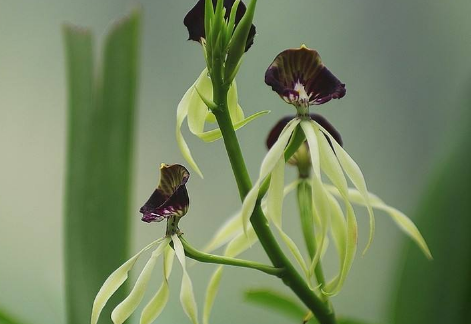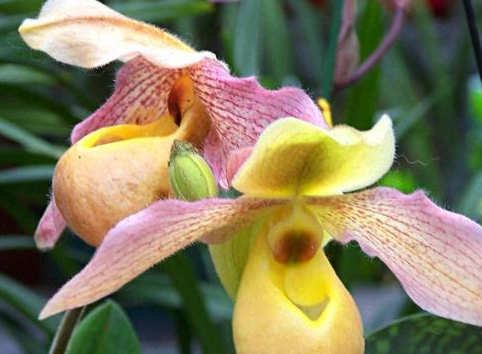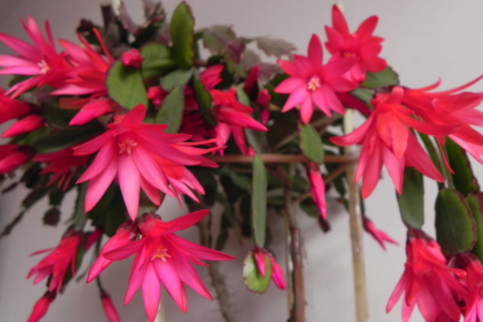Propagation method of octopus orchid
Ramet time
Octopus orchid is generally selected in summer, spring is the peak period of plant growth, and the ramet is easier to survive.
Ramet method
Take the exuberant plants out of the pot and pay attention to protecting the roots. You can shake off part of the soil, cut off the aged or dead roots, and trim the leaves. When dividing the plant into clusters, it is necessary to avoid hurting the buds and roots, and ensure that each clump must have at least 3 false bulbs, which is more conducive to the survival of the new plant.

Divide a good thickness to plant in time, pay attention to the side of the new bud toward the edge of the pot, false bulbs do not plant too deep or too shallow, can be slightly lower than the soil surface of two centimeters. After the ramet is placed in a cool place for care, do not water in the first 5 days, so as not to rot the roots, you can sprinkle a small amount of water on the leaves to ensure moisture.
The above is the culture method of octopus orchid. I believe that through scientific care and management, you will be able to grow beautiful octopus orchid.
The propagation method of octopus orchid
Psychological preparation
Octopus orchid variety is precious, you can feed a pot is not easy, you must be prepared before the split, not lazy, not spoiled, not biased, wholeheartedly raise many pots of octopus orchid.
Material preparation
Already full of pots of octopus orchid mother plants, sharp scissors, new soil, flowerpots. These are necessary, of course, if you are very experienced, you can also have your own tricks and tools, and choose them according to your personal habits.
Ramet time
All kinds of tools are ready, and the rest is to wait. Ramets are usually selected in spring, but before flowering.
Ramet method
Take the plant out of the pot first and be careful not to destroy the roots. In order to operate, water control will generally begin a week before the split to ensure that the soil is soft and easier to remove from the basin.
Treat the plant, shake off the old soil from the roots, trim the roots, cut off the aged and dead roots, and then cut off the dry leaves.
Separate clumps, separate plants, see how many pots you want to divide, try not to divide too little, generally full pot of octopus orchid divided into two pots. Be careful not to hurt the buds and roots during slicing. Each clump retains at least 3 false bulbs, so the survival rate is relatively high.
Put the pot, when planting pay attention to the new bud side to the edge of the basin, to leave enough space for its growth. Planting false bulbs should not be too deep or too shallow, slightly 1-2 cm below the surface of the soil.
After ramet, put it in a cool place and do not water it for 3-5 days, lest the wound in the ramet process will not heal in time and cause rot. As long as a small amount of water is sprayed on the leaves to ensure that the plant does not shrink.
For about a week or so, the new roots and buds will grow normally, and then they will be properly maintained with other plants.
How to raise white octopus claws / how to reproduce white octopus claws Chinese name: White octopus claws Latin name: Ebracteola wilmaniae family: octopus claws brief introduction: White octopus claws are perennial herbs, very fleshy, tufted. The base of the opposite leaf is United into a fleshy sheath, and the whole opposite leaf resembles a slender pair of pliers. The leaves are flat adaxially, convex and angled abaxially, with thin epidermis and many translucent spots. Leaves tall 4~8cm, basally United. The young plants are solitary, while the old ones are dense. White octopus claws are perennial herbs, very fleshy and tufted. The base of the opposite leaf is United into a fleshy sheath, and the whole opposite leaf resembles a slender pair of pliers. The leaves are flat adaxially, convex and angled abaxially, with thin epidermis and many translucent spots. Leaves tall 4~8cm, basally United. The young plants are solitary, while the old ones are dense. Leaves green to grayish green, flowers open from the middle of the two leaves, white flowers, diameter about 3-5cm, stem short, generally only one to two per plant, group flowering will be very spectacular. It opens in the sunny afternoon from late autumn to early spring and closes at night, so the day opens and the night closes for about 7 days. In case of rainy days or insufficient light in the cultivation place, it is difficult to open, and the plants are cross-pollinated. White octopus claws are easier to live in groups. After sowing for 2 years, there will be 1 desquamate and 3 heads per year. If the number of desquamated heads in the coming year will be reduced to 1 to 1, then the plant can split into clumps and clumps of small groups. Only in this way will the nutrition be resupplied, and the heads will gradually become normal, and the plants will dormancy in summer and grow in other seasons. The desquamation period is similar to the stone flower, but the peeling period is longer, and the peeling period is more sunny and less watery. The peeling of the white octopus claws is that the old skin on the outside slowly dries up and nutrients are provided to the new plants. the leaves of the new plants will grow at the same time as the old leaves, sometimes stacked one after another. The plant is made of cinder mixed with a small amount of peat and the soil is covered with granular river sand. The plant material is mainly permeable and breathable, this variety is not very resistant to the sun, it must be sunshaded in summer, it can be desquamated and grown in spring, and it can be properly hydrated during peeling. This variety can give water when it is dry and thoroughly. Otherwise, the new leaves are easy to sunburn or droop and wither, generally dry and thoroughly watered, and they are watered without soaking. The whole summer sunshade, put in the bright and ventilated scattered light, summer will also give a small amount of water, more will rot. The water supply can be restored after the autumn temperature comes down, step by step. From late winter to early spring, they will blossom brilliantly. If the plant is full, it does not need to be hydrated. If you find that the leaves are a little weak, you will replenish the water immediately. It is necessary to avoid frostbite caused by too low temperature in winter. There is no problem when the basin soil is dry at minus 3 degrees. There is a big difference between the north and the south, and flower lovers should breed according to their own environment. Reproduction can be sown or ramets, and meat cones are beautiful only when they are born in groups. [/ td] [/ tr] [/ table]
- Prev

Propagation methods of Paphiopedilum
Ramet propagation is the main propagation method of Paphiopedilum. Potted Paphiopedilum can be divided once every two or three years. Generally, there will be a short dormant period after flowering, and it can be divided at this time. First of all, take the plant out of the pot and clean up the soil from the roots so as not to hurt the buds. Separate the plants, each with two or three buds
- Next

What if the dance of falling flowers does not blossom
The flowering of the mother plant of falling flowers is different from that of cutting or grafting. Generally speaking, the growth state of the mother plant will be better after it is propagated by cutting or grafting, but the mother plant will wither. However, one of the advantages of the mother plant is that it can easily grow buds.
Related
- Fuxing push coffee new agricultural production and marketing class: lack of small-scale processing plants
- Jujube rice field leisure farm deep ploughing Yilan for five years to create a space for organic food and play
- Nongyu Farm-A trial of organic papaya for brave women with advanced technology
- Four points for attention in the prevention and control of diseases and insect pests of edible fungi
- How to add nutrient solution to Edible Fungi
- Is there any good way to control edible fungus mites?
- Open Inoculation Technology of Edible Fungi
- Is there any clever way to use fertilizer for edible fungus in winter?
- What agents are used to kill the pathogens of edible fungi in the mushroom shed?
- Rapid drying of Edible Fungi

